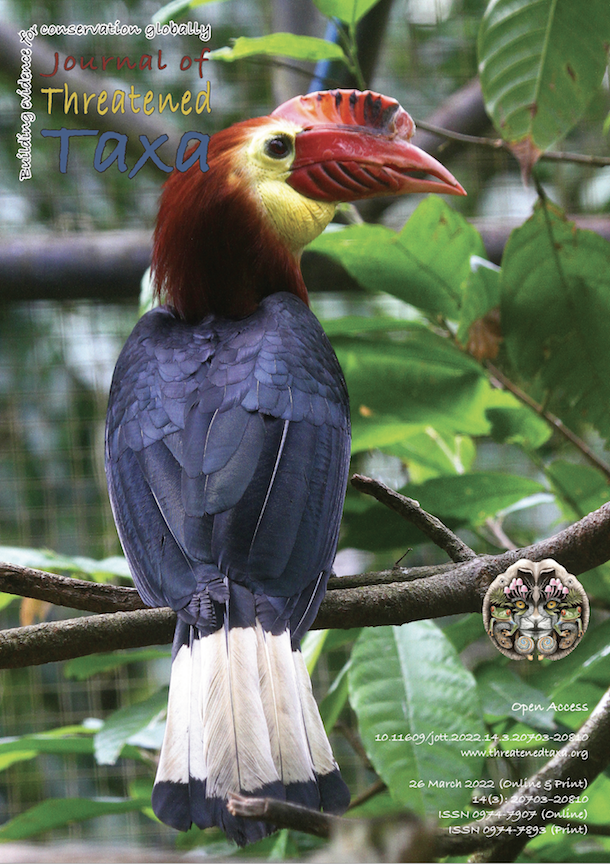A new distribution record of Memecylon clarkeanum Cogn. (Melastomataceae) to Karnataka from Sharavathi river basin, central Western Ghats, India
Main Article Content
Abstract
Memecylon clarkeanum Cogn., a vulnerable species, is reported as a new record for Karnataka from primeval sacred forest, Rameshwara Devarakadu of Hulkodu village in the region of Sharavathi river basin, Sagar taluk, Shivamogga district, central Western Ghats. The present discovery highlights the importance of sacred groves in conserving rare, endangered and endemic flora. Prior to this, the species was reported as a new record for India from Kerala in 2012. The present paper illustrates the range extension of the species further towards northern latitudes up to central Western Ghats, Karnataka. The study assessed distributional range, habitat, ecology, status of threat, and vulnerability for planning conservation measures.
Article Details

This work is licensed under a Creative Commons Attribution 4.0 International License.
Authors own the copyright to the articles published in JoTT. This is indicated explicitly in each publication. The authors grant permission to the publisher Wildlife Information Liaison Development (WILD) Society to publish the article in the Journal of Threatened Taxa. The authors recognize WILD as the original publisher, and to sell hard copies of the Journal and article to any buyer. JoTT is registered under the Creative Commons Attribution 4.0 International License (CC BY), which allows authors to retain copyright ownership. Under this license the authors allow anyone to download, cite, use the data, modify, reprint, copy and distribute provided the authors and source of publication are credited through appropriate citations (e.g., Son et al. (2016). Bats (Mammalia: Chiroptera) of the southeastern Truong Son Mountains, Quang Ngai Province, Vietnam. Journal of Threatened Taxa 8(7): 8953–8969. https://doi.org/10.11609/jott.2785.8.7.8953-8969). Users of the data do not require specific permission from the authors or the publisher.
References
Bremer, K. (1979). Taxonomy of Memecylon (Melastomataceae) in Ceylon. Opera Botanica 50: 1–32.
Bremer, K. (1981). “Seeds and embryos in Sri Lanka (Ceylonese) species of Memecylon, with notes on Spathandra (Melastomataceae)”. Nordic Journal of Botany 1(1): 62–65. https://doi.org/10.1111/j.1756-1051.1981.tb01036 DOI: https://doi.org/10.1111/j.1756-1051.1981.tb01036.x
Clarke, C.B. (1879). Melastomaceae, pp. 512–565. In: Hooker, J.D. (ed.), The Flora of British India, Vol. 2. L. Reeve and Co., London.
Cooke, T. (1901). The Flora of the Presidency of Bombay - Volume I. Taylor & Francis, London.
Das, M. (2017). Taxonomic revision of the family memecylaceae dc. in India, Department of Botany, Calcutta University (unpublished).
Dassanayake, M.D. & F.R. Fosberrg (1987). Memecylon clarkeanum Cogn. In: A Revised Handbook to the Flora of Ceylon. Vol. VI. Oxford & IBH Publishing C. Pvt. Ltd., New Delhi.
Gamble, J.S. (1994). Memecylon, pp. 500–505. In: Flora of the presidency of Madras. London, part. 111.
Gopalakrishna, K.B. (2003). Memecylon. In: Flora of Udupi. Manipal Press Limited, Manipal, 219 pp.
Herbarium JCB (2012). Retrieved 23 March 2020 from http://flora-peninsula-indica.ces.iisc.ac.in/herbsheet.php?id=5727&cat=7
Herbarium JCB (2020). Retrieved 23 March 2020 from http://florakarnataka.ces.iisc.ac.in/hjcb2/search.php
HerbWeb (2020). Retrieved 17 October 2020, from http://apps.kew.org/herbcat/detailsQuery.do?barcode=K000357752
Linnaeus, C. (1753). Species Plantarum. Laurentius Salvius, Stockholm, 1,200 pp.
Melastomataceae.Net (2020). Retrieved 16 October 2020 from http://www.melastomataceae.net/
Memecylon, L. (2018). Retrieved 17 October 2020 from Plants of the World Online http://www.plantsoftheworldonline.org/taxon/urn:lsid:ipni.org:names:26452-1
Ramaswami, S.N., R.M. Radhakrishna & D.A. Govindappa (2001). Memecylon, pp. 239–240. In: Flora of Shimoga District, Karnataka. Prasaranga.
Saldanha, C.J. & S.R. Ramesh (1984). Memecylon In: Flora of Karnataka. Oxford & IBH, New Delhi.
Sivu, A.R., M.K.R. Narayanan, E.S.S. Kumar, K.A. Sujana, N.S. Pradeep, N.A. Kumar & A.G. Pandurangan (2012). Memecylon clarkeanum Cogn. (Melastomataceae ) - a threatened species, new record for India. Taiwania 57(3): 327–330. https://doi.org/10.6165/tai.2012.57(3).327
Trimen, H. (1894). A Handbook to the flora of Ceylon, Part-II. London.
Udhayavani, C. & V.S. Ramachandran (2013). On the occurrence of Memecylon clarkeanum Cogn. (Melastomataceae ) - a vulnerable species from Nilgiris, Tamil Nadu, India. Journal of Threatened Taxa 5(3): 4811–4814. https://doi.org/10.11609/JoTT.o3638.4811-3 DOI: https://doi.org/10.11609/JoTT.o3638.4811-3
World Conservation Monitoring Centre (1998). Memecylon clarkeanum. The IUCN Red List of Threatened Species 1998: e.T33517A9789376. Accessed on 19 March 2022. https://doi.org/10.2305/IUCN.UK.1998.RLTS.T33517A9789376.en DOI: https://doi.org/10.2305/IUCN.UK.1998.RLTS.T33517A9789376.en

